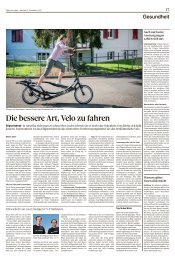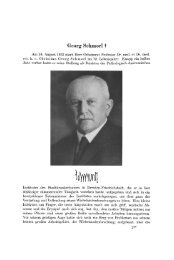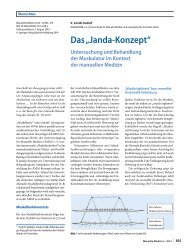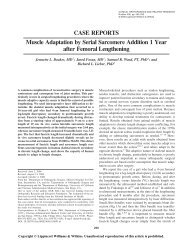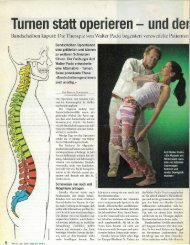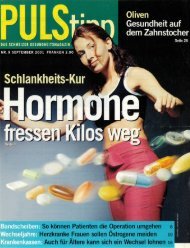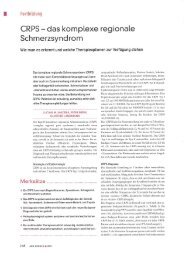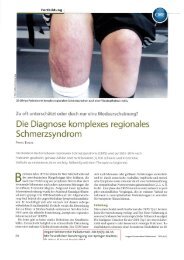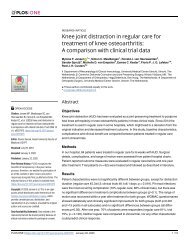Vladimir Janda, MD, DSc
You also want an ePaper? Increase the reach of your titles
YUMPU automatically turns print PDFs into web optimized ePapers that Google loves.
SPINE Volume 31, Number 9, pp 1060–1064<br />
©2006, Lippincott Williams & Wilkins, Inc.<br />
<strong>Vladimir</strong> <strong>Janda</strong>, <strong>MD</strong>, <strong>DSc</strong><br />
Tribute to a Master of Rehabilitation<br />
Craig E. Morris, DC, FACCRS,* Philip E. Greenman, DO, FAAO,†<br />
Margaret I. Bullock, AM., B Sc App, PhD, FTSE,‡<br />
John V. Basmajian, OC, O Ont, <strong>MD</strong>, <strong>DSc</strong>, FRCPC,§ and Alena Kobesova, <strong>MD</strong><br />
The purpose of this presentation is to pay tribute to the<br />
life’s work of Professor <strong>Vladimir</strong> <strong>Janda</strong>, a key figure in the<br />
20th Century rehabilitation movement. An accomplished<br />
neurologist, he founded the rehabilitation department at<br />
Charles University Hospital in Prague, Czechoslovakia. He<br />
was one of the seminal members of the Prague school of<br />
manual medicine and rehabilitation that expanded its influence<br />
throughout Central and Eastern Europe. His observations<br />
regarding muscle imbalances, faulty posture<br />
and gait, and their association with chronic pain syndromes,<br />
etiologically, diagnostically, and therapeutically,<br />
influenced the rehabilitation world. The authors comprise<br />
a multinational, multiprofessional group representative of<br />
rehabilitation specialists around the world who would like to<br />
pay tribute and give a final word of thanks to this innovative<br />
educator, clinician, and author.<br />
Key words: rehabilitation, motor control, manual medicine,<br />
physical therapy, osteopathy, chiropractic. Spine<br />
2006;31:1060–1064<br />
Professor <strong>Vladimir</strong> <strong>Janda</strong> passed away on November 25,<br />
2002 in his native Prague, Czech Republic (Figure 1). An<br />
internationally renowned scholar, researcher, instructor,<br />
and clinician, his passing marked the beginning of a new<br />
era in the rehabilitation world. Defining the “post-<strong>Janda</strong><br />
era” requires a brief review of this great man’s life, message,<br />
and impact, which also may provide a glimpse into<br />
his vision for the future.<br />
Background<br />
Trained as a neurologist at Charles University, <strong>Janda</strong>’s<br />
passion for rehabilitation was forged in his teenage years<br />
when he contracted poliomyelitis. Although he overcame<br />
From the *Cleveland Chiropractic College–Los Angeles, California,<br />
Post-Graduate Faculty, Southern California University of Health Sciences,<br />
Whittier, California, and Post-Graduate Faculty, Rehabilitation,<br />
Canadian Memorial Chiropractic College, Toronto, Ontario, Canada;<br />
†Osteopathic Manipulative Medicine, Physical Medicine and Rehabilitation,<br />
Michigan State University College of Osteopathic Medicine;<br />
‡School of Health and Rehabilitation Sciences, University of Queensland,<br />
Brisbane, Australia; §Department of Medicine and Anatomy,<br />
Faculty of Health Sciences, McMaster University, and Rehabilitation<br />
Centre, Chedoke-McMaster Hospital, Hamilton, Ontario, Canada;<br />
and Department of Rehabilitation, University Hospital Motol, Second<br />
Medical Faculty, Charles University, Prague, Czech Republic.<br />
Acknowledgment date: September 8, 2005. Acceptance date: September<br />
23, 2005.<br />
The manuscript submitted does not contain information about medical<br />
device(s)/drug(s).<br />
No funds were received in support of this work. No benefits in any<br />
form have been or will be received from a commercial party related<br />
directly or indirectly to the subject of this manuscript.<br />
Address correspondence and reprint requests to Craig E. Morris, DC,<br />
FACCRS, F.I.R.S.T. Health, 22924 Crenshaw Blvd., Torrance, CA<br />
90505; E-mail: rehabdoc@att.net<br />
the initial quadriplegia and being subsequently wheelchair-bound<br />
for 3 years, he was left with a significant<br />
impairment. Still, it seemed to many observers that he<br />
was never disabled and instead empowered by this lifelong<br />
challenge. His understanding of rehabilitation was<br />
based on the function of what he called the “sensorymotor”<br />
system, which placed greater emphasis on dynamic<br />
neurologic control, or “motor control,” than the<br />
commonly used term of the “neuromusculoskeletal system.”<br />
He integrated the inspirational work of his predecessors<br />
such as Sherrington, Pavlov, Still, Palmer, Kabat,<br />
Kenny, J.B. Mennell, and Mitchell, Sr, along with Czech<br />
contemporaries such as Lewit, Jirout, Vele, Cihak, and<br />
Vojta. He paid special tribute to his mentor in Prague,<br />
Professor Henner.<br />
Never restricted by linguistic barriers, <strong>Janda</strong> integrated<br />
the writings of various European language researchers<br />
into his knowledge base. Already an established<br />
researcher in his own right, he honed his<br />
neurologic research skills when he traveled to Canada in<br />
the 1960s to become the first postdoctoral student of<br />
Professor John Basmajian, considered the “father of<br />
EMG biofeedback therapy.” Basmajian wondered, in the<br />
end, who taught whom more, the supposed teacher or<br />
the pupil. Ultimately, he acknowledged that <strong>Janda</strong> became<br />
a world leader in the rational therapy of musculoskeletal<br />
conditions and of manual medicine. 1 In addition<br />
to collaborative research with Basmajian, 2 <strong>Janda</strong> subsequently<br />
integrated his acquired skills of neurophysiological<br />
testing into his research work in Czechoslovakia<br />
(Figure 2).<br />
A review of <strong>Janda</strong>’s published works demonstrates the<br />
breadth of his clinical interest and influence. His published<br />
papers varied greatly in their focus: from pediatrics<br />
3 to geriatrics, 4 in addition to the effects of pediatric<br />
conditions on the adult, 5 from the latest in neurodiagnostic<br />
testing 6 to the latest on rehabilitation and manual<br />
medicine standards, 7,8 from postural 9,10 to neurologic<br />
disorders, 5,11 and from ankle conditions 12 to obscure<br />
facial pain. 13 In addition to publishing several texts in<br />
Czech, <strong>Janda</strong> subsequently published his books in German<br />
and English. 14,15<br />
Regional Accomplishments<br />
Professor <strong>Janda</strong> was the Founding Director of the Department<br />
of Rehabilitation Medicine and the Director of<br />
the School of Physiotherapy at the Charles University,<br />
Third School of Medicine. A clinician extraordinaire, he<br />
supervised the management of conditions ranging from<br />
1060
Tribute to <strong>Vladimir</strong> <strong>Janda</strong>, <strong>MD</strong>, <strong>DSc</strong> • Morris et al<br />
1061<br />
spawned an explosion of new research and clinical methods.<br />
As the depth of his understanding and message expanded,<br />
his reputation grew to create a great deal of interest<br />
beyond the borders of the “Iron Curtain.”<br />
Figure 1. <strong>Vladimir</strong> <strong>Janda</strong>, <strong>MD</strong>, <strong>DSc</strong> 1928 –2002.<br />
macro-traumatic quadriplegias to degenerative neurologic<br />
disorders to the micro-traumatic chronic pain syndromes<br />
so common in the industrialized world. Along<br />
with his Czech colleagues, known as “The Prague School,”<br />
they established new standards in manual medicine and<br />
rehabilitation throughout the Soviet Union and Central Europe.<br />
Based on a deep understanding of research-based<br />
neurophysiology, this complex yet practical approach<br />
International Growth and Influence<br />
The 1960s and 70s brought <strong>Janda</strong> invitations to attend<br />
international conferences on rehabilitation and manual<br />
medicine. His continued multilingual, multinational<br />
writing and lectures brought greater acclaim, along with<br />
a broader scope of interaction among the world’s foremost<br />
experts in the field. He became a consultant to the<br />
World Health Organization, establishing rehabilitation<br />
hospitals in third world countries around the globe. He<br />
was an editorial staff member of numerous international<br />
journals and the editor in chief of the Czech Journal,<br />
Rehabilitation and Physical Medicine, until his death.<br />
During the past two decades, Professor <strong>Janda</strong> taught<br />
both undergraduate and postgraduate groups at medical,<br />
physiotherapy, osteopathic, and chiropractic schools<br />
and conferences around the world on a regular basis. He<br />
was a leader in the formation and growth of the International<br />
Federation of Manual Medicine. In all venues, his<br />
depth of knowledge, charismatic personality, and clinical<br />
skills and insights inspired researchers, instructors,<br />
clinicians, and students alike to accept a deeper appreciation<br />
of the neurophysiologic aspect of locomotor function,<br />
the etiology of its dysfunction, and the utilization of<br />
strategies, based on such knowledge, to overcome such<br />
dysfunction.<br />
Attending one of Professor <strong>Janda</strong>’s courses was a<br />
memorable experience. A prodigious reader of the literature<br />
with a gifted memory, he routinely recalled supporting<br />
literature when challenged, which varied from<br />
Figure 2. EMG results of a prone<br />
patient from <strong>Janda</strong>’s 1960s research<br />
illustrate his interest in motor<br />
control. In this instance, he<br />
demonstrated hip extension activity.<br />
(Reproduced from <strong>Janda</strong> V.<br />
Pokroky v rehabilitaci [Advances<br />
in Rehabilitation]. Prague: Statni<br />
zdravotnicke nakladatelstvi, 1968,<br />
with permission.)
1062 Spine • Volume 31 • Number 9 • 2006<br />
the most obscure, decades-old citation to very recent papers,<br />
often providing a personal comment about the author<br />
of the paper or international conference at which it<br />
was presented.<br />
Professor <strong>Janda</strong> inspired a plethora of research and<br />
was frequently consulted to assist in ongoing research<br />
projects. Over the ensuing decades, his continuing lectures,<br />
writings, and demonstrations filtered down<br />
through a myriad of multigenerational protégés. The<br />
breadth and scope of his influence ultimately infiltrated<br />
the entire rehabilitation world.<br />
<strong>Janda</strong>’s Message<br />
It was in the 1960s that Professor <strong>Janda</strong> first proposed<br />
that motor function must be considered with respect to<br />
the three interdependent neuro-musculo-articular systems.<br />
Instead of emphasizing musculoskeletal mobility<br />
and strength, his message focused on neuromotor control<br />
and locomotor system functional stability. 15–17 He<br />
continued offering this message and highlighting its implications<br />
for clinical assessment and practice throughout<br />
his career.<br />
<strong>Janda</strong>’s thesis was that dysfunction of the joints, muscles,<br />
or nervous system would be reflected in the quality<br />
of function of the others, not only at a local level but also<br />
globally.<br />
This process of dissipation of effect was broadly described<br />
as “vertical and horizontal generalization” of<br />
motor dysfunction.<br />
<strong>Janda</strong> emphasized the importance of the clinical integration<br />
of anatomy and kinesiology, what he described<br />
as functional anatomy (See Figure 3). A firm grasp of this<br />
association allowed him to better understand dysfunction<br />
in the locomotor system, which frequently occurred<br />
in a predictable manner. He described characteristic patterns<br />
of muscle hyper- and hypo-activity, called muscle<br />
imbalances, which initially manifest around the pelvis<br />
and/or the shoulder girdles. He also demonstrated stereotypical<br />
alterations in motor control, or incoordination,<br />
of muscle firing patterns present that would lead to<br />
expected postural and gait disturbances and pain syndromes.<br />
These observations led to the establishment of<br />
“<strong>Janda</strong>’s Postural syndromes,” which included the “Upper<br />
Crossed Syndrome” (Figure 4), the “Lower Crossed<br />
Figure 3. This illustration depicts <strong>Janda</strong>’s emphasis on functional<br />
anatomy in his explanation of the etiology of locomotor system<br />
dysfunction and pain syndromes. (Reproduced from <strong>Janda</strong> V.<br />
Vysetrovani hybnosti [Examination of the Movements]. Prague:<br />
Avicenum zdravotnicke nakladatelstvi, 1972:19, with permission.)<br />
Figure 4. Illustration of <strong>Janda</strong>’s Upper (aka proximal) Crossed<br />
Syndrome. From the lateral view, this postural syndrome explains<br />
how antagonistic muscles become imbalanced, resulting in compromised<br />
posture. <strong>Janda</strong> explained that this left the patient with<br />
altered spinal and shoulder region biomechanics and increased<br />
the risk of associate pain syndromes. (Reproduced from Chaitow L.<br />
Muscle Energy Techniques, 2nd ed. London: Elsevier, 1996, with<br />
permission.)
Tribute to <strong>Vladimir</strong> <strong>Janda</strong>, <strong>MD</strong>, <strong>DSc</strong> • Morris et al<br />
1063<br />
Figure 5. A depiction of <strong>Janda</strong>’s Lower (aka Distal) Crossed Syndrome.<br />
Note that one line of the cross demonstrates hypertrophic<br />
(tight) muscle, while the other demonstrates hypotrophic (weak)<br />
muscle. (Reproduced from Chaitow L. Muscle Energy Techniques,<br />
2nd ed. London: Elsevier, 1996, with permission.)<br />
Figure 6. <strong>Janda</strong> emphasized the importance of postural and gait<br />
assessment as a clinical shortcut and confirmatory clinical modality.<br />
Here he describes the stereotypical “Antalgesic Posture.”<br />
(Reproduced from <strong>Janda</strong> V, Kraus J. Neurologie pro rehabilitacni<br />
pracovniky [Neurology for Physiotherapists]. Prague: Avicenum<br />
zdravotnicke nakladatelstvi, 1987:126, with permission.)<br />
Syndrome” (Figure 5), and the “Layer Syndrome.” Recent<br />
studies and books have helped to support and<br />
strengthen the basis of <strong>Janda</strong>’s observations. 18–22<br />
<strong>Janda</strong>’s approach to assessment stressed the need to<br />
address dysfunction in all three systems, and he extended<br />
a profoundly rational approach to the management of<br />
different clinical presentations. He stressed the importance<br />
of postural and gait assessment as part of a complete<br />
locomotor system evaluation, noting that observation<br />
of stereotypical postures (Figure 6) could be used as<br />
clinical shortcuts or for confirmatory purposes. He demonstrated<br />
methods to log these findings quickly (Figure<br />
7), while also reminding clinicians to avoid overreliance<br />
on such findings. 23<br />
For chronic pain syndromes, <strong>Janda</strong> highlighted the<br />
importance of first reducing any joint dysfunction or nociception<br />
in order to improve the local afferentation.<br />
Muscle imbalances could then be normalized with manual<br />
techniques and muscle firing patterns improved via<br />
sensorimotor training. Once this was accomplished, specific<br />
therapeutic exercises designed to neutralize the<br />
chronic dysfunction and improve endurance and<br />
strength could be appropriately introduced. 24,25 Clini-
1064 Spine • Volume 31 • Number 9 • 2006<br />
Professor <strong>Vladimir</strong> <strong>Janda</strong> did indeed provide a unique<br />
breadth, depth, and scope of clinical influence throughout<br />
the world. As such, history will memorialize him as<br />
being one of the true giants of the 20th Century rehabilitation<br />
movement.<br />
References<br />
Figure 7. One of <strong>Janda</strong>’s drawings demonstrating postural assessment.<br />
He emphasized the local and global assessment as part of<br />
a complete examination, teaching methods that allowed the examiner<br />
to quickly log his or her findings. (Reproduced from <strong>Janda</strong><br />
V. Dokumentace analyzy stoje [How to record stance analysis].<br />
Rehabilitace a Fyzikalni lekarstvi 1994:4 –5, with permission.)<br />
cians from around the world have come to understand<br />
and use these fundamental approaches to treatment, perhaps<br />
only a percentage of these appreciating from whom<br />
this approach originated.<br />
Professor <strong>Janda</strong> considered his most profound finding<br />
involved the central nervous system and congenital risk<br />
factors for chronic pain syndromes. At an influential<br />
New York conference in the 1970s, he proposed that the<br />
pediatric syndrome of minimal brain dysfunction might<br />
indeed persist into adulthood. His seminal summary of<br />
his research later appeared in English. 26 While these findings<br />
have become routinely applied in Central Europe for<br />
years, validation of this complex topic will be necessary<br />
before universal acceptance and clinical integration occurs.<br />
In the light of growing interest in biopsychosocial<br />
factors of chronic pain and disability, <strong>Janda</strong> envisioned a<br />
significant clinical impact of minimal brain dysfunction<br />
as further research leads to a more comprehensive understanding<br />
of the topic.<br />
A New Era<br />
With his passing, the rehabilitation world is only now<br />
coming to fully appreciate the accomplishments of Professor<br />
<strong>Janda</strong>. The contributors of this tribute exemplify<br />
the unifying nature of his multilingual, multinational,<br />
multiprofessional influence and, in his honor, challenge<br />
the ensuing generations to further prove and expand on<br />
his tenets. As a group, we thank him for helping us to<br />
open our eyes. In his native Czech Republic, he was posthumously<br />
entitled the “Father of Czech Rehabilitation.”<br />
1. Basmajian J. I.O.U.: Adventures of a Medical Scientist. Hamilton, Ontario,<br />
Canada: J&D, 1993:57–8.<br />
2. Simard T, Basmajian J, <strong>Janda</strong> V. Effects of ischemia on trained motor units.<br />
Am J Phys Med 1968;47:64–71.<br />
3. <strong>Janda</strong> V. Cervicocranial syndrome in children. Ceska Pediatr 1959;14:<br />
1018–22.<br />
4. <strong>Janda</strong> V, Kadlec M. Questions of rehabilitation of aged orthopedic patients.<br />
Acta Chir Orthop Traumatol Cech 1982;49:480–2.<br />
5. <strong>Janda</strong> V, Kraus J, Brazdilova N. Study of adults with infantile cerebral palsy:<br />
I. Dynamics of movement difficulties in adults with infantile cerebral palsy.<br />
Ceska Neurol Neurochir 1981;44:57–60.<br />
6. Vele F, <strong>Janda</strong> V. Comparison of the monopolar and bipolar polyelectromyographic<br />
technique. Electromyography 1965;5:97–8.<br />
7. <strong>Janda</strong> V. A model for the education of rehabilitation personnel in Czechoslovakia.<br />
Z Gesamte Hyg 1971;17:394–6.<br />
8. <strong>Janda</strong> V, Lewit K, Horynova M, et al. Modern schools of thought and<br />
developmental trends in manual medicine. Cas Lek Cesk 1979;118:545–9.<br />
9. <strong>Janda</strong> V. What is the typical upright posture in man? Cas Lek Cesk 1972;<br />
111:748–50.<br />
10. <strong>Janda</strong> V. The significance of muscular faulty posture as pathogenetic factor<br />
of vertebral disorders. Arch Phys Ther (Leipz) 1968;20:113–6.<br />
11. <strong>Janda</strong> V, Skorpil V, Vele F. Fibrillation activity of a denervated muscle in<br />
poliomyelitis patients influenced experimentally. Cas Lek Cesk 1960;99:<br />
551–3.<br />
12. Bullock-Saxton M, <strong>Janda</strong> V, Bullock M. The influence of ankle sprain injury<br />
on muscle activation during hip extension. Int J Sports Med 1994;15:330–4.<br />
13. <strong>Janda</strong> V. Some aspects of extracranial causes of facial pain. J Prosthet Dent<br />
1986;56:484–7.<br />
14. <strong>Janda</strong> V, Pavlu D. Manuelle Muskelfunktionsdiagnostik. München: Urban<br />
& Fischer Verlag, 2000.<br />
15. <strong>Janda</strong> V. Muscle Function Testing. London: Butterworth, 1983.<br />
16. <strong>Janda</strong> V. Postural and phasic muscles in the pathogenesis of low back pain.<br />
Proceedings of the XIth Congress ISRP, Dublin, 1968:553–4.<br />
17. <strong>Janda</strong> V, Schmidt J. Muscles as a pathogenic factor in back pain. Proceeding<br />
from the International Federation of Orthopedic Manual Therapists, New<br />
Zealand, 1980.<br />
18. Falla D, Jull G, Hodges P. Patients with neck pain demonstrate reduced<br />
electromyographic activity of the deep cervical flexor muscles during performance<br />
of the craniocervical flexion test. Spine 2004;29:2108–14.<br />
19. Falla D, Jull G, Hodges P. Feedforward activity of the cervical flexor muscles<br />
during voluntary arm movements is delayed in chronic neck pain. Exp Brain<br />
Res 2004;157:43–8. Epub 2004 Feb 5.<br />
20. Hodges P, Moseley G, Gabrielsson A, et al. Experimental muscle pain<br />
changes feedforward postural responses of the trunk muscles. Exp Brain Res<br />
2003;151:262–71.<br />
21. Hodges P, Moseley G. Pain and motor control of the lumbopelvic region:<br />
effect and possible mechanisms. J Electromyogr Kinesiol 2003;13:361–70.<br />
22. Hodges P, <strong>Janda</strong> V. Functional control of the low back. In: Morris C, ed.<br />
Low Back Syndromes: Integrated Clinical Management. New York:<br />
McGraw-Hill, 2006.<br />
23. Morris C, Chaitow L, <strong>Janda</strong> V. Functional assessment of low back syndromes.<br />
In: Morris C, ed. Low Back Syndromes: Integrated Clinical Management.<br />
New York: McGraw-Hill, 2006.<br />
24. Jull G, <strong>Janda</strong> V. Muscles and motor control in low back pain: assessment and<br />
management. In: Twomey L, Grieve G, eds. Physical Therapy of the Low<br />
Back. Melbourne: Churchill Livingstone, 1987:253–78.<br />
25. Murphy D, Morris C. Rehabilitation strategies in low back syndromes. In:<br />
Morris C, ed. Low Back Syndromes: Integrated Clinical Management. New<br />
York: McGraw-Hill, 2006.<br />
26. <strong>Janda</strong> V. Muscles, central nervous motor regulation and back problems. In:<br />
Korr I, ed. Neurobiologic Mechanisms in Manipulative Therapy. New York:<br />
Plenum Press, 1978:27–41.




